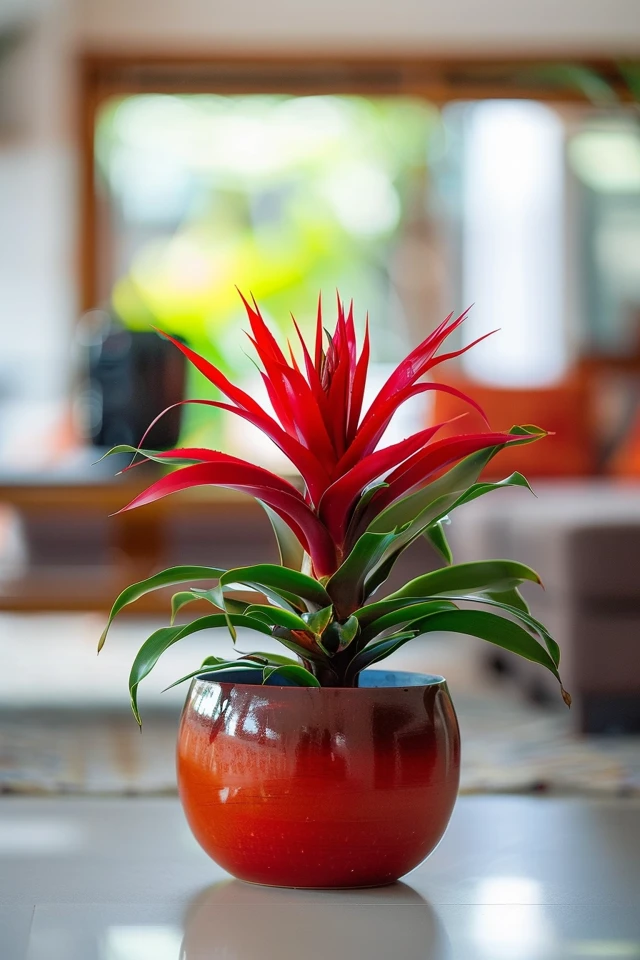Growing bromeliads can be a rewarding experience, as these tropical and subtropical plants bring vibrant colors and beauty to any space. To ensure their growth and vitality, bromeliads require proper care and periodic repotting. In this guide, I will walk you through the steps of repotting a bromeliad to promote renewed growth and rejuvenation.
Key Takeaways:
- Proper care is essential for the growth and vitality of bromeliads.
- Bromeliads thrive in well-drained potting mix and require sufficient light, proper watering, and good air circulation.
- Repotting bromeliads can help refresh the root system and promote optimal growth.
- Bromeliads can be propagated through pups, which are small offshoots that grow from the base of the plant.
- By following the proper care techniques and rejuvenating your bromeliads, you can enjoy a thriving and expanding collection.

Repotting a Bromeliad for Optimal Growth
When it comes to caring for your bromeliads, repotting plays a crucial role in ensuring their optimal growth and vitality. Most bromeliads have limited root systems and are typically grown in pots that are slightly small for their size. As they mature, a young plant may outgrow its current container, necessitating repotting.
One of the best practices for bromeliad repotting is to choose a slightly larger pot. This allows the plant’s root system to have enough space to expand, promoting healthy growth. Additionally, using a well-draining potting mix is essential for bromeliads as it helps prevent root rot and provides the necessary nutrients.
When repotting your bromeliad, fill the pot with the new mix, ensuring that the plant is planted at the same depth as its lowest leaves. This helps maintain stability and prevents the plant from becoming too top-heavy.
Proper maintenance of the bromeliad’s root system is crucial for its overall health. By refreshing the root system through repotting, you can ensure optimal growth and prevent any issues that may arise from being root-bound.
We recommend refreshing your bromeliad’s potting soil every 1-2 years to provide it with fresh nutrients and ensure its continued health and vigor.
Another vital aspect of bromeliad repotting is proper watering. It is important to allow the potting mix to slightly dry between waterings to prevent overwatering, which can lead to root rot. Bromeliads have the ability to hold water in their leaf centers and absorb water through their leaves. This unique characteristic makes them suitable for growing in containers, as well as in their natural epiphytic habitat.
The cup-like shape of many bromeliads is an adaptation for their tree-dwelling nature. This feature allows them to hold water and survive between rains, making them resilient and adaptable plants. Furthermore, bromeliads that produce flowers often have vibrant bracts or modified leaves accompanying them, adding to their visual appeal.

Refreshing Your Bromeliad’s Soil:
- Choose a slightly larger pot
- Use a well-draining potting mix with added perlite or finely ground pine bark
- Plant the bromeliad at the same depth as its lowest leaves
- Maintain appropriate moisture levels, allowing the potting mix to slightly dry between waterings
By following these best practices for bromeliad repotting and ensuring proper root system maintenance, you can help your bromeliad thrive and achieve its full growth potential. Repotting is a great opportunity to refresh the soil, provide essential nutrients, and promote optimal growth for your beloved bromeliad.
Propagating Bromeliads through Pups
After blooming, a bromeliad gradually declines and eventually dies. However, before dying, it produces small offshoots known as pups from its base. Pups can be separated from the original plant when they are about one-third of its size. Simply pull or cut the pup off at the point where it is attached to the mother plant.
Pot the pup in a small container with the appropriate potting mix and provide it with slightly less light until it develops a root system. Then, gradually increase the light exposure to the recommended level. As the pup grows, it can be repotted into larger containers until it reaches the same size pot as the original plant.
Pups generally bloom about one to two years after separation with proper care. Dividing bromeliad pups is an excellent way to expand your bromeliad collection and develop your propagation skills. It is a joy to see your collection multiply and have extras to share with friends or trade for new varieties.

Conclusion
Bromeliads are stunning plants that can bring a touch of tropical beauty to your indoor or outdoor spaces. By following the right care tips and techniques, you can ensure the continuous growth and vibrancy of your bromeliad collection. Whether it’s through proper care, repotting, or propagating pups, you have the power to nurture and expand these captivating plants.
Providing sufficient light, appropriate watering, and good air circulation are essential for the optimal growth of bromeliads. Remember to choose the right potting mix when repotting, ensuring that it drains well to prevent waterlogging. Refreshing the root system through repotting can stimulate new growth and keep your bromeliads thriving.
Additionally, bromeliad plant propagation is an exciting way to multiply your collection. Separating and potting pups from the mother plant allows you to propagate new bromeliads and share their beauty with others. With a little patience, you can nurture these pups into thriving plants and expand your bromeliad collection over time.
So, embrace the joy of caring for bromeliads and indulge your passion for their captivating colors and unique foliage. With the right techniques and a little love, you can enjoy the beauty and variety that bromeliads bring to your gardening endeavors.
Source Links
- https://www.nola.com/entertainment_life/home_garden/bromeliads-101-how-to-properly-pot-divide-and-grow-them-in-south-louisiana/article_061f7ce0-1444-59b5-b5d1-257e85b1f955.html
- https://www.lsuagcenter.com/portals/communications/news/news_archive/2011/august/get_it_growing/heres-how-to-grow-bromeliads-from-pups
- https://www.nola.com/entertainment_life/home_garden/bromeliads-101-how-to-pot-grow-and-divide-these-beauties/article_ea215398-a898-5ac3-82be-0430c70fc097.html

